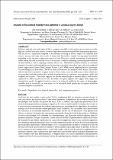Analysis of household food demand patterns in Laikipia County, Kenya

View/
Publication Date
2017-03-24Author
Mwenjeri Gabriel, Mwakubo Samuel, Kipsat Mary, Koome Mwambia
Metadata
Show full item recordAbstract/
In Kenya, arid and semi-arid lands (ASALs), comprise some 80% of the country and are characterized by high rates of food insecurity, natural resources degradation and unsustainable land management practices. This has led to a significant disruption of bio-diversity resulting in adverse impact on traditional food sources, income and other basic needs of many rural households, thereby leaving many households depending on the markets as their main source of food. Therefore, careful examination of food demand trends among the rural households serves as a precursor to effective planning, monitoring and evaluation of interventions as well as targeting assistance effectively. Guided by neoclassical theory of consumer demand, of a negative relationship between the quantities demanded and product’s price, the study employed Linear Approximate Almost Ideal Demand System (LA/AIAIDS) model, applying Iterative Seemingly Unrelated Regression Procedure (ITSUR) to study food demand in Laikipia County, Kenya. The results indicate that food commodities are price inelastic; Maize, beans, meat and milk are necessities while fruits and vegetables and other foods (which include wheat products, rice, potatoes, sweet potatoes, millet and sorghum) are luxuries. The results suggests that income rather than price oriented policies will be more significant in addressing food insecurity. Secondly, food price regimes that support both supply and demand sides need to be applied for food security to be achieved; and lastly, the impact of demographic variables such as household size, education level of household head, gender and occupation should be considered in policy formulation.
